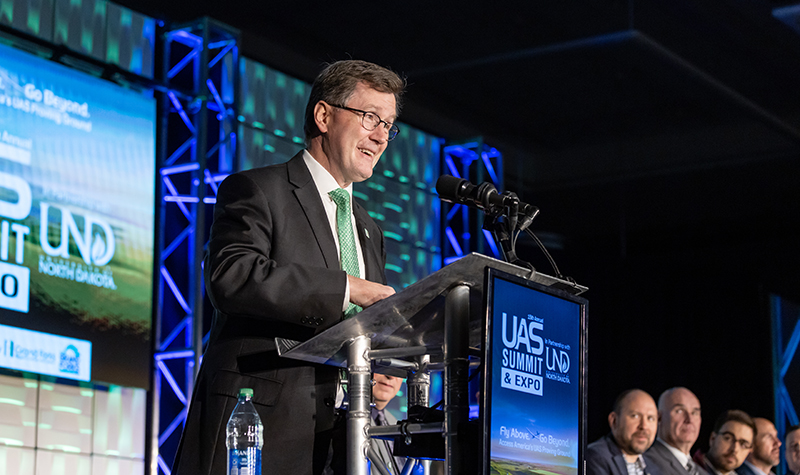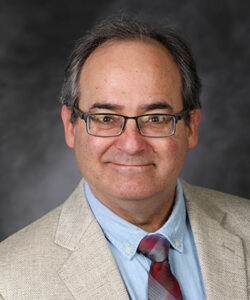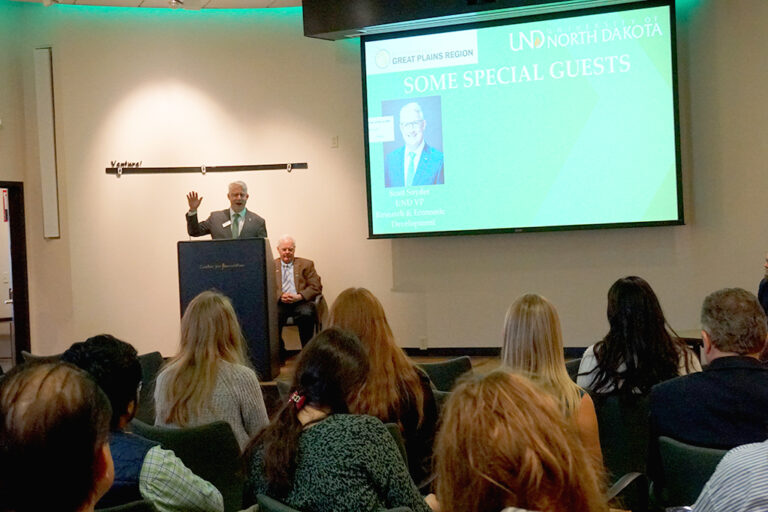Meeting the UAS workforce challenge
At the UAS Summit & Expo, top executives including NDUS Chancellor Mark Hagerott gave their recruiting-and-retention ideas

The most Midwestern of sights is the origin story of the most American invention of all.
And if it happened once, it can happen again, as Midwesterners turn their creative and industrious minds to the revolution in autonomous systems, said Mark Hagerott, North Dakota University System chancellor, at a Workforce Development seminar on Oct. 14.
At the UAS Summit & Expo, which UND co-sponsored and was held at the Alerus Center in Grand Forks, Hagerott took part in a two-hour, 10-person panel discussion titled, “Accelerate to Industry: Workforce Opportunities and Higher Education in the UAS Sector.”
When his time came to speak, Hagerott told the story of Philo T. Farnsworth, a farm boy and inventor who grew up in rural Utah and Idaho. In 1920, while farming his family’s potato field, the teen-aged Farnsworth noted the sight that travelers through farm country have commented on forever: the wonderfully straight and parallel lines of furrows, stretching off into the distance.
Eureka. Using electronics, an image could be broken down into lines, then get transmitted and reassembled by a distant device, young Farnsworth realized. And if you ever noticed how “Leave it to Beaver” showed up on your old black-and-white screen as a set of thin horizontal lines, you’ll know why Farnsworth often is remembered as the Father of TV.

High-quality workforce
Importantly, Farnsworth was typical of his region in many ways, not unique. Want proof that other farm-state youngsters share his creativity and drive, and are up to the task of designing autonomous systems?
Talk to Michael Billups, Lead Systems Engineer for Northrop Grumman’s Grand Sky facility by Grand Forks Air Force Base.
“A few of us who work out at Grand Sky came from California, and one of the things that we really were impressed with out here is our interns,” said Billups, a panelist at the Oct. 14 event.
In fact, “our site director commented one time, ‘What happened to all the interns?’ Well, it turned out they’d all turned into full-time employees.
“With the leadership they exhibit and their ability to work on teams, UND interns are better than any other interns I’ve seen,” Billups continued. “And I’ll put my interns here against any Level One or Level Two employees anywhere.”
That’s the talent the autonomous-systems industry in North Dakota can attract, Hagerott said. And throughout the session, Hagerott, Billups and the other panelists brainstormed ways of doing just that.
The conversation’s moderator, UND Associate Dean of Graduate Studies Chris Nelson, also came up with the idea for the session, said UND President Andy Armacost in starting the discussion off.
“Some months ago, Chris came up to me and said, ‘Hey, at the UAS Summit, let’s see if we can highlight workforce development,” Armacost said.
The theme also let Nelson connect the session with Accelerate to Industry, a program that prepares graduate students for industry and government-agency careers. Some 100 A2i participants nationwide watched the session’s livestream to learn more about UAS opportunities, Nelson said.

Pilots, project managers, personnel directors, photographers …
What they saw was first, a consensus that autonomous systems likely will rival telephones and television in their impact on modern life; and second, that the industry has great jobs for lots of people in all kinds of fields.
“Our enterprise covers a very wide spectrum,” said panelist Dean Gorder, the UND alum who directs the General Atomics facility at Grand Sky.
That means General Atomics nationwide “needs highly skilled production workers, highly skilled engineers, programmers, accountants,” he said.
And lesser-known professionals such as project managers and systems engineers are some of the most valuable executives of all. “If you have a project or a program manager who understands all of these disciplines and can effectively communicate the need for a timeline and other factors, that’s going to greatly enhance success,” Gorder said.
Of course, recruiting STEM talent remains a special challenge, in North Dakota and around the world. One long-term solution, the panelists agreed, lies in not just recruiting talent but also developing it – and not just among college students, but during childhood.
Even among grade schoolers, mentorship and individualized attention can make all the difference, said Nick Zaccardi, Chief Technical Officer at Airtonomy, a Grand Forks-based startup.
“There’s a 10-year-old who’s living behind us, and I find out he’s a nerd like me,” Zaccardi said.
“So, when I happen to have a drone at the house, I say, ‘Come on over. Come see the drone.’ ”
The two neighbors start dissembling the machine, and to Zaccardi’s amazement, the youngster already knows and can identify many of the parts. “I thought, ‘Oh my gosh, you’re way smarter than I was when I was a 10-year-old,’” Zaccardi said.
And that’s how a lifelong devotion to technology and invention can begin. “We’ve got to be willing to do that,” Zaccardi continued. “We’ve got to be willing to sacrifice our time to show these kids that this is valuable, that this is worth it.”

Bridging the gap
Panelist Frank Matus agreed. In Baldwinsville, N.Y., Matus works as Director of Air Traffic Control and Digital Aviation Solutions for Thales, an aerospace and defense electronics multinational. He’s also a member of the Baldwinsville Central School Board, and from that experience, he’s learned that schools can’t generate a STEM workforce on their own.
“I think industry can do a better job in showing students what the potential is,” Matus said.
K-12 teachers are doing their best to teach the curriculum, while school administrators have their hands full making sure their institutions run properly. So it’s left to industry (as well as colleges and universities) to really get across the promise and excitement of STEM careers: In Matus’ view, “industry has a responsibility to kind of bridge that gap.”
In North Dakota, two major tech-focused projects are worth noting. The first is Emerging Digital Academy. This immersive 20-week code school in Fargo is offered by Emerging Prairie, an entrepreneurial-ecosystem nonprofit.
But importantly, the Academy is less a standalone project than it is a capstone, because Emerging Prairie starts trying to spark young people’s interest much earlier.
Among the key initiatives that Grand Farm – another Emerging Prairie initiative – is developing are relationships with K-12 districts and youth groups such as FFA, Future Farmers of America, said William Aderholdt, panelist and Grand Farm Program Manager.
“We want these young people to be able to see themselves as engineers, and to realize that they really do belong in these fields,” Aderholdt said.
Diversity makes a difference
And at the post-secondary level, the North Dakota University System now has a “coding boot camp” (and then some) all its own: the Dakota Digital Academy. A cooperative effort across all 11 of the system’s campuses, the academy’s mission is to “provide motivated learners with access to quality digital-cyber education, training, certificates and knowledge,” the Academy’s website states.
“Under DDA sponsorship, faculty members at NDUS institutions are designing and developing 25 courses related to digital enterprises,” the website continues. “Educational opportunities will be offered via distance education, face-to-face on a campus, and through special traveling courses, workshops, boot camps and seminars throughout the state. … A new web portal will enable learners to access these and related courses, which will fulfill valuable learning objectives and complete requirements towards certificates in cybersecurity and software development.”
Of vital importance, North Dakota’s five tribal colleges also are Dakota Digital Academy partners, Hagerott said. That will both greatly expand those colleges’ technical offerings, plus invite an underrepresented population to join the state’s autonomous-systems workforce.
For example, suppose a tribal college has only one computer-science instructor. “By being part of a larger consortium, that person is now one of at least 16,” meaning 11 NDUS campuses plus five tribal colleges, Hagerott said.
“That means they can chat, they can share classes, they can start to realize that hey, they’re not alone.” They’re part of a team – and now, the tech tools and training of the full University System are available to them and their students.
It is “absolutely imperative” that the UAS and other autonomous-systems industries find ways to make women, American Indians and other underrepresented minorities feel welcome, Hagerott said. Because among other considerations, those populations represent a huge potential workforce; and in autonomous systems, one of America’s most rewarding and fastest growing industries, “we’re going to need all of the talented people we can get.”



